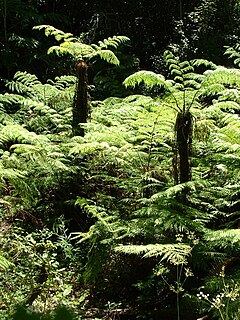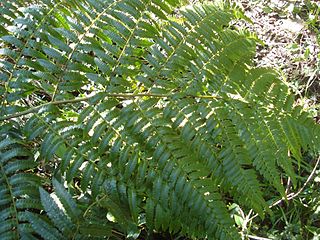Cyathea alleniae is a species of tree fern native to the Malay Peninsula, where it grows in forest margin on steep ground at an altitude of approximately 1200 m. The trunk is erect, about 4 m tall and 15 cm in diameter. It is usually unbranched, but may branch to form several small crowns. Fronds are bi- or tripinnate and 1–2 m long. The stipe is spiny at the base and at least partially covered by scales. Typically of section Alsophila, these scales are dark brown, glossy, and have fragile edges. Sori occur near the midvein of fertile pinnules and are covered by firm, brown indusia that resemble scales in appearance.
Cyathea amintae is a species of tree fern native to Puerto Rico, where it grows in shaded areas and cloud forest at an altitude of 1000–1200 m. The erect trunk may be 1.3 m tall and approximately 5 cm in diameter. Fronds are pinnate and up to 1.6 m long. The rachis is often purplish brown and covered with scales, usually on the underside. The scales range in colour from golden brown to bicoloured. Sori occur along each side of the pinnule midvein and indusia are cup-like.
Cyathea archboldii is a species of tree fern native to New Guinea and Bougainville, where it is common in submontane rain forest at an altitude of 1000–3000 m. The trunk is erect and up to about 3 m tall. Fronds are bipinnate and 2–3 m long. The rachis may be purplish and has short spines and scales. The scales range in colour from pale to brown, to bicoloured and have fragile edges. Sori occur in two rows along each side of the pinnule midvein and are covered by firm indusia.

Cyathea capensis is a regionally widespread and highly variable species of tree fern. It is indigenous to Southern Africa and South America.
Cyathea decrescens is a species of tree fern endemic to Madagascar. The trunk is erect, 2–3 m tall and 10–12 cm in diameter. It usually has characteristic elliptical scars caused by fallen stipe bases. Fronds are bipinnate and 1-1.5 m long. The fronds may be densely pubescent and the lower pinnules are sometimes separated from the others as well as being reduced. The rachis and stipe are brown in colouration and bear narrow, dark brown scales. Sori are large, round and covered by fragile, brown indusia.

Cyathea dregei is a widespread species of tree fern in southern Africa.
Cyathea erinacea is a species of tree fern native to Mexico, Costa Rica, Panama, Venezuela, Colombia, Ecuador, Peru and Bolivia.
Cyathea exilis is a species of tree fern endemic to the Cape York Peninsula in Queensland, Australia, where it grows in vine forest on a substrate of sandstone. It is a rare plant known only from one location, specifically by a stream in Mann Creek in the William Thompson Range. In its natural habitat, C. exilis is reportedly accompanied by Pandanus and Calamus plants. The trunk is erect, up to 4 m tall and 4–8 cm in diameter. It produces several buds, often one at each stipe base. Fronds are bipinnate and up to 1 m long. The rachis and stipe range in colour from brown to dark brown or black-brown and are covered in blunt spines and scales. The scales are dull brown in colour and bear terminal setae, mostly one each. Sori are round and occur on either side of the pinnule midvein. Indusia are absent.
Cyathea fenicis is a species of tree fern native to the Philippines, Taiwan, and Orchid Island, where it grows in wet forest, forest margins and on hillsides. The trunk is erect, up to 1 m tall and about 6 cm in diameter. Fronds are tripinnate and 1.5–2 m long. Characteristically of this species, the lowest pinnae are usually reduced. The stipe is spiny and ranges in colour from brown to purple-dark brown. It bears two types of scales: long dark brown scales as well as minute brown ones. Occasionally the scales are pale. Sori are round and arranged in two rows, one on either side of the pinnule midvein. They are covered by very small indusia that resemble scales in appearance.
Cyathea ferruginea is a species of tree fern endemic to the Philippines.
Cyathea gleichenioides is a species of tree fern endemic to New Guinea, where it grows in open peaty grassland and on forest margins, often in groups, at an altitude of 2800–3700 m. The trunk of this plant is erect, up to 3 m tall and about 24 cm in diameter. The narrow fronds are tripinnate and about 1 m in length. Around 60 fronds form a rounded crown.The stipe is warty and bears scattered scales towards the base. These scales may be either glossy brown with a paler dull margin, or small, pale and fringed. Sori occur one or two per fertile pinnule and are protected by firm, brown indusia.
Cyathea hancockii is a species of tree fern native to the Ryukyu Islands, Japan, Taiwan and Hong Kong. The specific epithet hancockii commemorates William Hancock (1847-1914), who collected numerous plants in Japan, China and Southeast Asia. It grows in forest, on stream banks, and in forest margins at an elevation of about 600 m or higher.
Cyathea hancockii is a species of tree fern endemic to Kinabalu National Park in Borneo, where it grows in ridge forest at an altitude of 2400–3000 m. It is a rather small species, having an erect trunk about 50 cm tall or more. Fronds are narrow, erect and tripinnate. They are usually about 1 m in length. The stipe is dark and warty. It bears medium brown scales with fragile edges. Sori are borne on either side of the midvein of fertile pinnules and protected by firm, dark indusia.

Cyathea delgadii is a widespread species of tree fern native to Costa Rica, Panama, Venezuela, French Guiana, Guyana, Trinidad, Colombia, Ecuador, Peru, Bolivia, Argentina, Paraguay, and Brazil.
Cyathea hooglandii is a species of tree fern native to the Western Highlands of New Guinea, where it grows in mossy forest at an altitude of about 3000 m. The trunk of this plant is erect, up to 3 m tall and approximately 10 cm in diameter. Fronds are tripinnate, 1–2 m in length and produced in two whorls of five to seven each. The stipe may be dull and warty or densely covered with scales. These scales range in colour from dark to medium brown and have a broad, paler margin as well as fragile edges. Perhaps the most distinguishing feature of this species are its sori, which are borne singly at the base of each tertiary pinnule on the midvein. They are protected by firm indusia that are saucer-like in appearance.
Cyathea hornei is a species of tree fern. Its natural distribution covers eastern New Guinea and the Louisiade Archipelago to Fiji, where it grows in wet submontane forest, stunted forest, mossy forest, and on ridges, at an altitude of 400–2000 m. The trunk of this plant is erect, 3–4 m tall and up to about 4 cm in diameter. Fronds may be pinnate or bipinnate and reach a length of 2 m. Basal scales cover the dark rachis and stipe of this species. These scales are glossy and either bicoloured or light brown and bullate. Sori almost cover the lower segments of fertile pinnules. Indusia are absent.
Cyathea propinqua is a species of tree fern native to Fiji and possibly Samoa, where it grows in wet forest. The trunk of this plant is erect and slender, growing to 10 m in height. Fronds may be bi- or tripinnate and 2–3 m long. Dull brown scales cover the dull, dark stipe of this species. The scales are minute along most of its length, becoming thick and fleshy towards the base. Sori are borne halfway between the pinnule midvein and the edge of the lobe. Indusia are present.
Cyathea imbricata is a species of tree fern endemic to Western New Guinea, where it grows in open forest at an altitude of 3240 m. The trunk of this plant is erect and approximately 2 m tall. Fronds may be bi- or tripinnate and are usually less than 1 m in length. The stipe is dark, spiny, and covered with caducous scales. These scales are glossy brown in colouration and have a paler margin and fragile edges. Sori are borne in groups of one to four per pinnule lobe. They are protected by firm indusia.
Cyathea insulana is a species of tree fern native to New Guinea, where it grows in mossy forest and ravines at an altitude of 750–1600 m. The trunk of this species is erect, 8–10 m tall, and 14 cm in diameter. Fronds may be bi- or tripinnate and approximately 3 m in length. They form a spreading crown. The stipe bears thick spines as well as scales. These scales are either small, pale brown, with a short fringe, or large and glossy brown, with fragile edges. Sori are borne near the fertile pinnule midvein. They are protected by thin, pale indusia.
Cyathea latipinnula is a species of tree fern native to the Philippines, where it grows in ridge forest at an altitude of about 1400 m. The trunk of this plant is erect and grows to 1–2 m in height and 10 cm in diameter. Fronds may be bi- or tripinnate and 1–2 m in length. The stipe is spiny and bears a few narrow, brown basal scales. Sori are borne near the fertile pinnule midvein and are protected by small, dark indusia.








